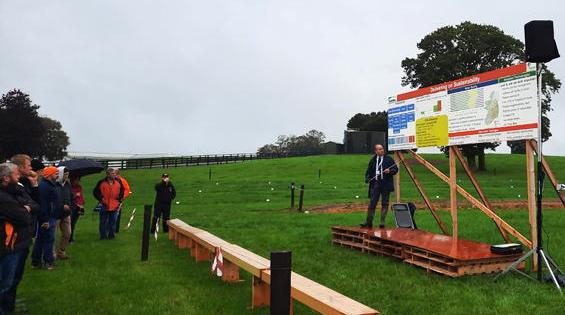The opening adress at the Teagasc Moorepark Open Day set the scene for the day.
Laurence Shalloo, Teagasc research officer, painted a positive picture of the industry, pointing out improvements which can be made and opportunities for the future.
Commenting that emission reduction targets lie ahead in the form of climate budgets, Shalloo was confident in reaching the targets.
He said that while we are seeing the effects of climate change, with more summer droughts and winter rainfall, and while the average Irish dairy herd has one of the lowest carbon footprints in the world there is work to be done.
The Irish dairy industry's carbon footprint stands at 0.99kg CO2/kg FPCM (kg of carbon dioxide equivalents per kg of Fat and Protein Corrected Milk)
When carbon sequestration is added in that figure drops to 0.86kg CO2/kg FPCM.
Improvements
Increasing fertility, productivity, using stabilised urea, increasing clvoer levels and reducing nitrates on farms can all help to bring that carbon footprint down to 0.73kg CO2/kg FPCM, according to Shalloo.
By including sequestration that figure will drop to 0.61kg CO2/kg FPCM.
"The technologies you see today can get us down to these figures," he explained.
Methane is one of the biggest challenges facing livestock production in Ireland and Shalloo stated that Teagasc research has shown that dairy animals are actually emitting less methane than has been estimated in the past as emissions in the spring time are much lower. He noted that this could see emission figures reduced by 7%.
What is methane?
The researcher went on to describe how methane is a flow gas, meaning that a cow produces methane today and in 10 years' time that methane will be oxidised and available to be taken up by the plant.
In contrast, the carbon dioxide being released from cars is released into the atmosphere and stays there for thousands of years.
"There is a really distinct difference between the two and that means we have to count them differently. Now we count them the same, we have to count them differently as we go forward," Shalloo commented.
The GWP* metric has been shown to measure methane emissions more accurately, but emissions of the gas still need to be reduced.
"As an industry we have increased methane quite substantially in the last 10 years. We're going to have to start to stabilise and reduce over time now."
Reducing emissions
However, Shalloo explained there are simple things that can be done to reduce emissions.
"Every time we buy in feed, it's a higher intake, that means more methane. For example, we're feeding 1.1t of concentrate on average across the dairy herd to every cow. If that was 500-600kg we'd reduce methane nationally by 4%. Those types of decisions are something that we need to start thinking of as we go forward,"Shalloo stated.
Carbon storage
There was great interest in carbon storage on the stand and farmers were interested in how they could make a profit from this in the future, or how increasing carbon can increase soil health, reduce fertiliser dependence and improve water quality – another issue which the researcher noted is improving, but still requires work.







 This is a subscriber-only article
This is a subscriber-only article










SHARING OPTIONS: